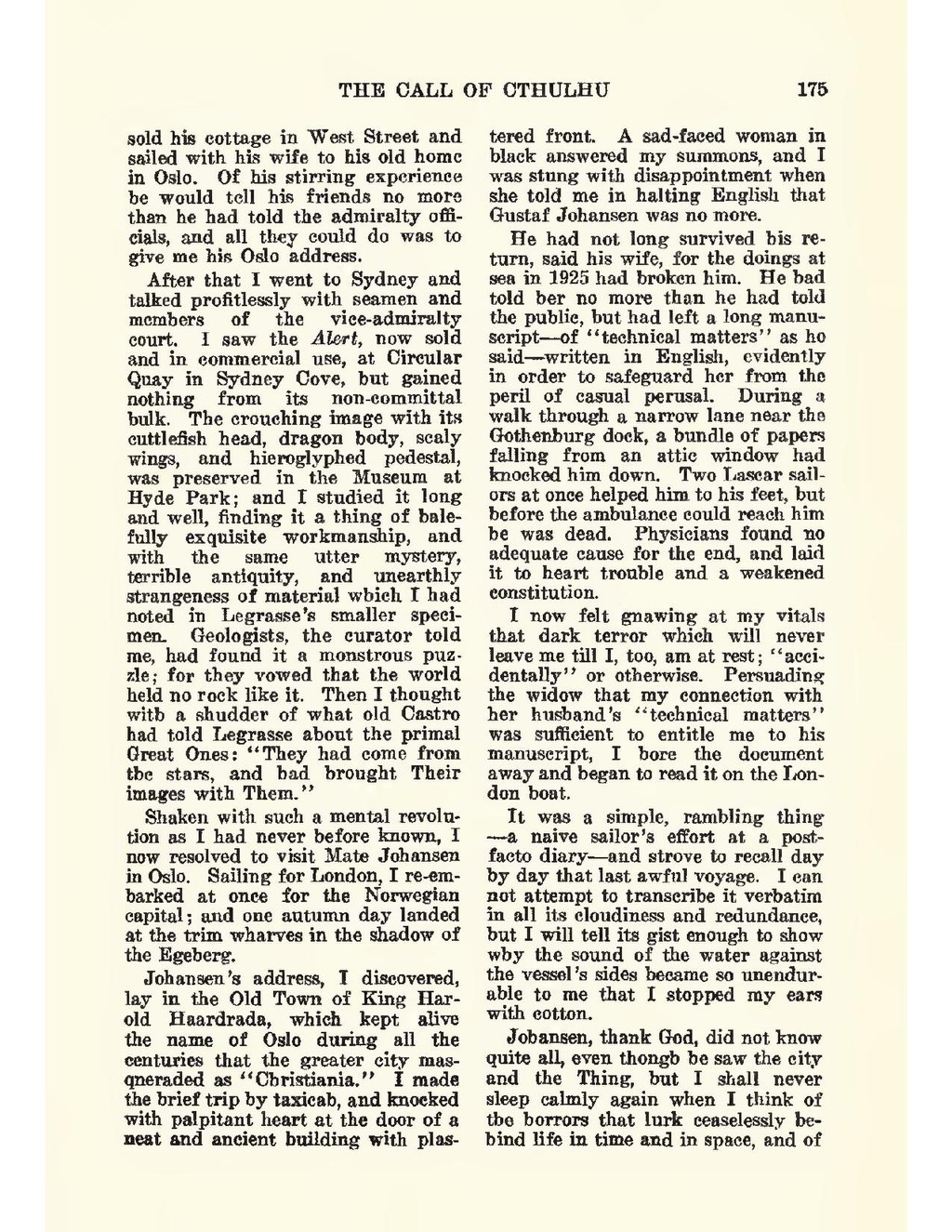sold his cottage in West Street and sailed with his wife to his old home in Oslo. Of his stirring experience he would tell his friends no more than he had told the admiralty officials, and all they could do was to give me his Oslo address.
After that I went to Sydney and talked profitlessly with seamen and members of the vice-admiralty court. I saw the Alert, now sold and in commercial use, at Circular Quay in Sydney Cove, but gained nothing from its non-committal bulk. The crouching image with its cuttlefish head, dragon body, scaly wings, and hieroglyphed pedestal, was preserved in the Museum at Hyde Park; and I studied it long and well, finding it a thing of balefully exquisite workmanship, and with the same utter mystery, terrible antiquity, and unearthly strangeness of material which I had noted in Legrasse’s smaller specimen. Geologists, the curator told me, had found it a monstrous puzzle; for they vowed that the world held no rock like it. Then I thought with a shudder of what old Castro had told Legrasse about the primal Great Ones: “They had come from the stars, and had brought Their images with Them.”
Shaken with such a mental revolution as I had never before known, I now resolved to visit Mate Johansen in Oslo. Sailing for London, I re-embarked at once for the Norwegian capital; and one autumn day landed at the trim wharves in the shadow of the Egeberg.
Johansen’s address, I discovered, lay in the Old Town of King Harold Haardrada, which kept alive the name of Oslo during all the centuries that the greater city masqueraded as “Christiania.” I made the brief trip by taxicab, and knocked with palpitant heart at the door of a neat and ancient building with plastered front. A sad-faced woman in black answered my summons, and I was stung with disappointment when she told me in halting English that Gustaf Johansen was no more.
He had not long survived his return, said his wife, for the doings at sea in 1925 had broken him. He had told her no more than he had told the public, but had left a long manuscript—of “technical matters” as he said—written in English, evidently in order to safeguard her from the peril of casual perusal. During a walk through a narrow lane near the Gothenburg dock, a bundle of papers falling from an attic window had knocked him down. Two Lascar sailors at once helped him to his feet, but before the ambulance could reach him he was dead. Physicians found no adequate cause for the end, and laid it to heart trouble and a weakened constitution.
I now felt gnawing at my vitals that dark terror which will never leave me till I, too, am at rest; “accidentally” or otherwise. Persuading the widow that my connection with her husband’s “technical matters” was sufficient to entitle me to his manuscript, I bore the document away and began to read it on the London boat.
It was a simple, rambling thing—a naive sailor’s effort at a post-facto diary—and strove to recall day by day that last awful voyage. I can not attempt to transcribe it verbatim in all its cloudiness and redundance, but I will tell its gist enough to show why the sound of the water against the vessel’s sides became so unendurable to me that I stopped my ears with cotton.
Johansen, thank God, did not know quite all, even though he saw the city and the Thing, but I shall never sleep calmly again when I think of the horrors that lurk ceaselessly behind life in time and in space, and of
